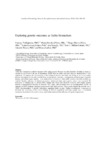Mostrar o rexistro simple do ítem
Exploring genetic outcomes as frailty biomakers
| dc.contributor.author | Valdiglesias, Vanessa | |
| dc.contributor.author | Sánchez-Flores, María | |
| dc.contributor.author | Marcos-Pérez, Diego | |
| dc.contributor.author | Lorenzo-López, Laura | |
| dc.contributor.author | Maseda, Ana | |
| dc.contributor.author | Millán-Calenti, José Carlos | |
| dc.contributor.author | Pásaro, Eduardo | |
| dc.contributor.author | Laffon, Blanca | |
| dc.date.accessioned | 2019-01-30T13:06:04Z | |
| dc.date.issued | 2018-04-19 | |
| dc.identifier.citation | Valdiglesias V, Sánchez-Flores M, Marcos-Pérez D, Lorenzo-López L, Maseda A, Millán-Calenti JC, Pásaro E, Laffon B. Exploring genetic outcomes as frailty biomakers. J Gerontol A Biol Sci Med Sci. 2019 Jan 16;74(2):168-175. | es_ES |
| dc.identifier.issn | 1079-5006 | |
| dc.identifier.uri | http://hdl.handle.net/2183/21638 | |
| dc.description.abstract | [Abstract] Frailty has emerged as a reliable measure of the aging process. Because the early detection of frailty is crucial to prevent or even revert it, the use of biomarkers would allow an earlier and more objective identification of frail individuals. To improve the understanding of the biological features associated with frailty as well as to explore different biomarkers for its early identification, several genetic outcomes-mutagenicity, different types of genetic damage, and cellular repair capacity-were analyzed in a population of older adults classified into frail, prefrail, and nonfrail. Besides, influence of clinical parameters-nutritional status and cognitive status-was evaluated. No association of mutation rate or primary DNA damage with frailty was observed. However, DNA repair capacity showed a nonsignificant tendency to decrease with frailty, and persistent levels of phosphorylated H2AX, as indicative of DNA breakage, increased progressively with frailty severity. These results support the possible use of H2AX phosphorylation to provide information regarding frailty severity. Further investigation is necessary to determine the consistency of the current findings in different populations and larger sample sizes, to eventually standardize biomarkers to be used in clinics, and to fully understand the influence of cognitive impairment. | es_ES |
| dc.description.sponsorship | This study was supported by Xunta de Galicia (ED431B 2016/013, ED431C 2017/49, FrailNet network IN607C 2016/08, and ED481B 2016/190-0 to V.V.) and by the COST Action CA15132, “hCOMET,” Spanish Ministry of Economy, Industry, and Competitiveness (Ramon y Cajal Research Fellowship RYC-2015–18394 to L.L.-L.), INDITEX-UDC (to M.S.-F. and D.M.-P.), and Deputación Provincial de A Coruña (to M.S.-F.). | es_ES |
| dc.description.sponsorship | Xunta de Galicia; ED431C 2017/49 | es_ES |
| dc.description.sponsorship | Xunta de Galicia; IN607C 2016/08 | es_ES |
| dc.description.sponsorship | Xunta de Galicia; ED481B 2016/190 | es_ES |
| dc.description.sponsorship | info:eu-repo/grantAgreement/MINECO/Programa Estatal de Promoción del Talento y su Empleabilidad/RYC-2015-18394/ES/ | es_ES |
| dc.description.sponsorship | Xunta de Galicia; ED431B 2016/013 | |
| dc.language.iso | eng | es_ES |
| dc.publisher | Oxford | es_ES |
| dc.relation.uri | https://doi.org/10.1093/gerona/gly085 | es_ES |
| dc.rights | This is the pre-copyedited, author-produced version of an accepted article for publication in The Journals of Gerontology: Series A followinf peer review. The version of record is avaliable online at Oxford Academic web page. | es_ES |
| dc.subject | DNA repair | es_ES |
| dc.subject | γH2AX | es_ES |
| dc.subject | TCR mutation | es_ES |
| dc.title | Exploring genetic outcomes as frailty biomakers | es_ES |
| dc.type | info:eu-repo/semantics/article | es_ES |
| dc.rights.access | info:eu-repo/semantics/embargoedAccess | es_ES |
| dc.date.embargoEndDate | 2019-04-19 | es_ES |
| dc.date.embargoLift | 2019-04-19 | |
| UDC.journalTitle | The Journals of Gerontology: Series A | es_ES |
| UDC.volume | 74 | es_ES |
| UDC.issue | 2 | es_ES |
| UDC.startPage | 168 | es_ES |
| UDC.endPage | 175 | es_ES |
Ficheiros no ítem
Este ítem aparece na(s) seguinte(s) colección(s)
-
GI-GIGG - Artigos [115]
-
INIBIC-IX - Artigos [31]






